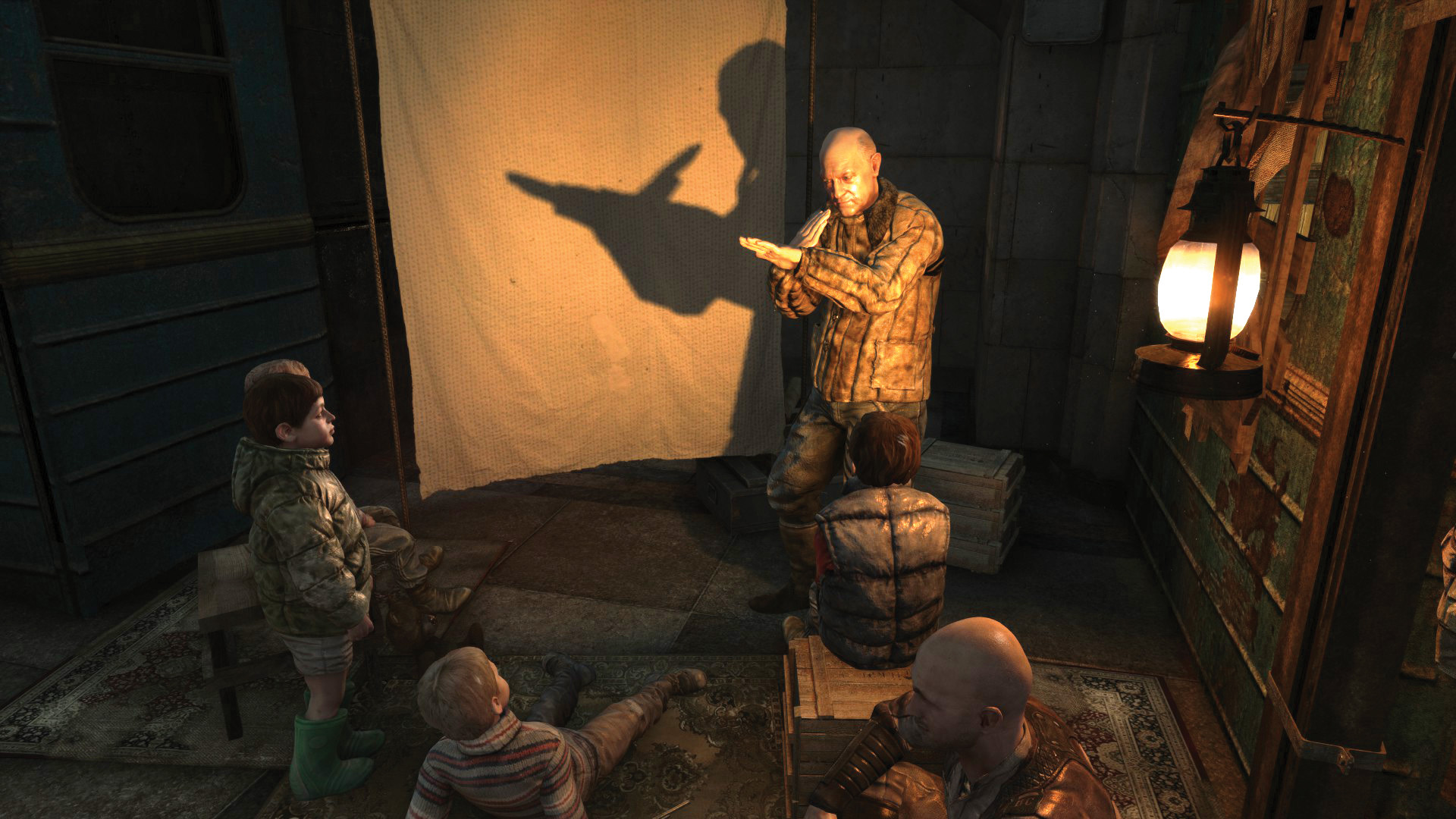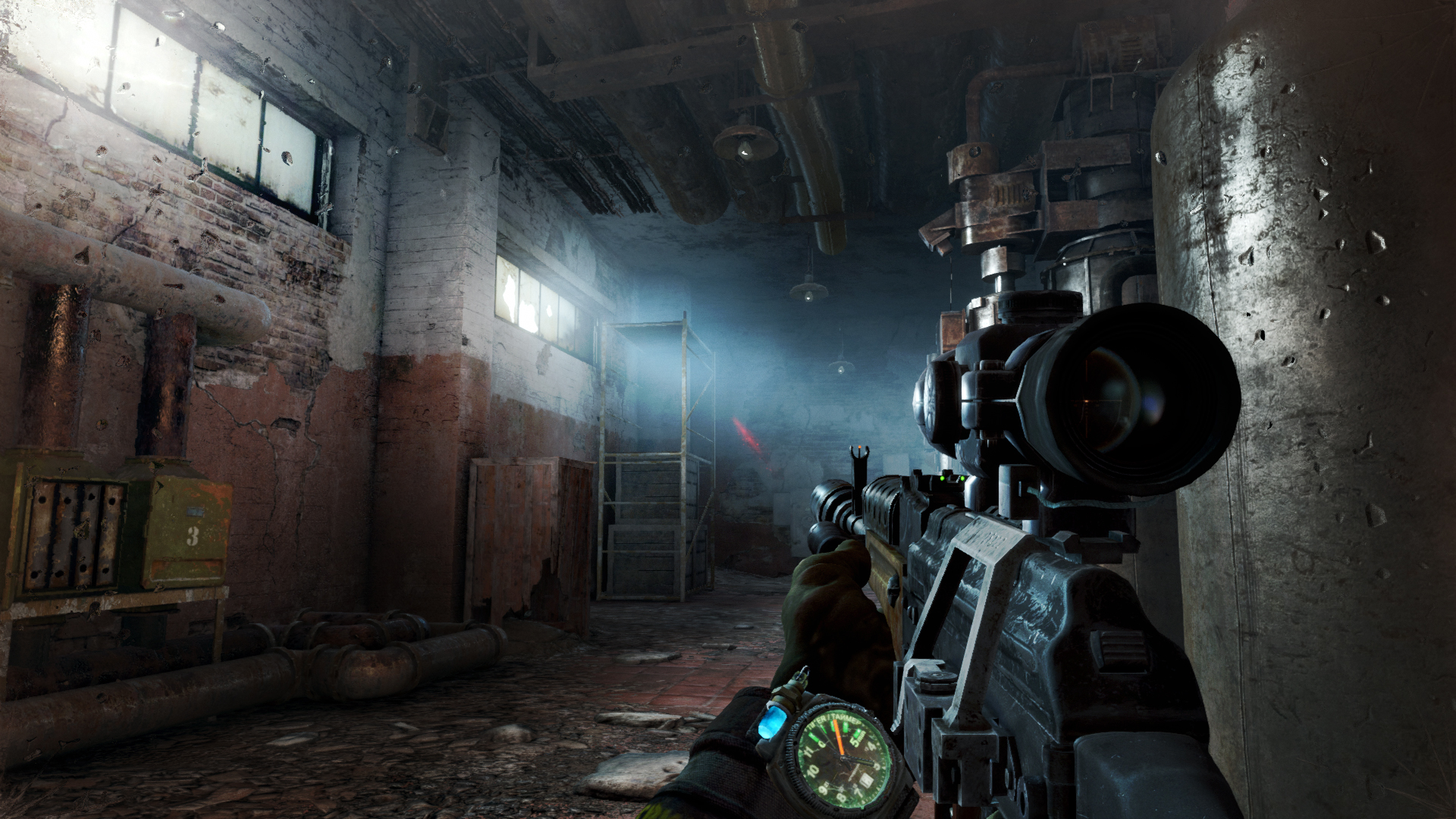
Metro’s 2033’s gas mask was what made the game more than just another post-apocalyptic FPS. By forcing you to wear this airtight faceplate, Metro maintained its sense of claustrophobia even when exploring a wide-open space. The tension of hearing your breath become laboured as the mask’s filter struggles to clean the toxins from the air. The cracks that appear as you’re battered about by the mutant wildlife. It’s more important to making Metro work as an experience than any of its guns.
But the gas mask is crucial to Metro’s immersion in another way. It acknowledges that the player is separated from the game world by a screen, and by separating the main character Artyom from the world in the same way, it compounds that sense of immersion, drawing the player deeper into the game world.
Metro: Last Light takes this idea one step further. As you explore the cracked and blasted landscape of irradiated Moscow, the mask will become gummed up with various substances, be it mud splashed up from a nearby puddle, or blood from an enemy you’ve just blasted with a shotgun. But with a quick tap of the G key, your character will wipe the faceplate clean with his left hand.
It’s an entirely unnecessary flourish, and yet this tiny action adds so much to Metro’s sense of immersion. To have the player character reach up and touch that screen from the inside of the game, that’s a whole other level of ingenuity, not simply turning the fourth wall into a window, but having the audacity to then knock on it.
This is why Metro: Last Light is my favourite variant of the post-apocalypse. It wraps you so tightly in its world building that at points your character is literally wearing it. It seems all the more impressive when you consider that, unlike Fallout, or Metro’s cousin Stalker, Last Light is staunchly linear. But linearity is what makes Metro’s fiction work, a style as much as it is a structure.
Tight fit

Metro turns claustrophobia into an aesthetic, constantly making the player feel squeezed and restricted as they traverse the labyrinthine tunnels of the Moscow subway system. The gas mask is one example of this, but there are others. The world is deliberately designed to feel cluttered, particularly in the settlements that the player passes through. The world is crammed with environmental details, as humanity tries to pull a city’s worth of resources underground. Even character attire is designed to appear bulky and cumbersome, making you feel even more pressed-in when passing through populated areas.
As a sequel, Last Light makes small but important improvements over 2033. From a mechanical perspective, stealth actually works, enabling players to use silenced weapons and melee attacks to take out guards from the shadows. The confined nature of Metro’s levels still makes stealth difficult, as you need to be very precise in your movements. But it’s no longer impossible.
Keep up to date with the most important stories and the best deals, as picked by the PC Gamer team.
The most significant changes are also the less tangible ones. Last Light is a better paced game than its predecessor, with a greater variety in level design and set pieces. In its approach, Last Light takes inspiration from Half-Life 2. This is apparent in the structure of the game, such as the way one level flows more neatly into the next, and the greater emphasis on NPC companions. But there are more specific areas where 4A has borrowed from Valve’s masterful sequel. There’s a sequence in which you drive a rail car through a tunnel infested with insectoid enemies; an obvious nod to Highway 17. Later, you have to navigate through the structure of a vast bridge, which again bears strong resemblance to a similar set piece in Half-Life 2.
Last Light also follows in the footsteps of Half-Life 2 by providing a more rounded and mature story compared to its predecessor. Metro 2033 concludes with Artyom unleashing a barrage of nuclear missiles to destroy a race of post-human mutants known as the Dark Ones. In the sequel, it transpires that the Dark Ones may not have been hell-bent on extinguishing humanity, and Artyom is plagued with guilt about being the man who pushed the button. As such, when Artyom is given a mission to track down and kill the last surviving Dark One, he instead decides to try to protect it.
Acting out

Last Light’s story is interesting and generally well written, but it fumbles the delivery with some wooden English voice acting and the cringeworthy representation of its few female characters. The scene in the strip club remains one of the least erotic things I’ve ever witnessed, and this is a game in which you fight giant mutated pigs.
Yet while Last Light has its lows, they are outweighed by its highs. Early on, you’re captured by the Metro’s Nazi faction, but are helped to escape by a Soviet soldier named Pavel. A goofy, affable fellow, Pavel is likeable, and the game does a great job at establishing the bond between him and Artyom. At one point, Pavel says, “We’re like the three musketeers… if there were two of them,” which sums up his personality.
It soon transpires this personality is a facade. Pavel is far more than a grunt in the Metro’s Red Army, and rather less than your friend. The moment he betrays you is genuinely galling, not least because you get the sense that, deep down, his sense of kinship toward you was not entirely feigned. Afterward, Pavel becomes the human focal point in Artyom’s mission, spending much of the rest of the game chasing his former comrade down. This culminates in a climactic battle near Red Square that is as spectacular as it is bittersweet.
The relationship between Pavel and Artyom is by far the game’s strongest human thread. But Last Light’s most impactful moments don’t stem from the living. Metro is at its best when exploring the eerie horror of its own imagined apocalypse. As you investigate the wreckage of a passenger jet, flashes of the plane’s final moments play before your eyes. Toward the end, you explore an area of Moscow where the shadows of the dead linger on, oblivious to their own demise. In one ruined apartment, the shadow of a child plays with his toys, waiting for a mother who no longer exists to come home. This is Metro’s world building at its most powerful, strange, haunting and tragic.
Guiding light

Through all this, Last Light never forgets its status as a shooter, and is built to play to a very satisfying rhythm, balancing its atmospheric storytelling with bouts of intense combat. The game uses a clever ‘feast and famine’ approach to dishing out ammo and mask filters. In one level you’ll feel prepared for anything, but in the next you’ll be down to throwing knives at your opponents as you gasp for air through your half-shattered mask. In my most recent playthrough, I actually ran out of ammo against one of the game’s (few) bosses, and would have been done for were it not for a single claymore mine hiding in my inventory.
The action also escalates in a surprisingly subtle way, guiding you towards increasingly perilous situations without you fully realising it. The final third of the game sees you trekking across the surface during a truly awe-inspiring thunderstorm, the wind whipping thick tendrils of rain across your vision as dazzling bolts of lightning fork down from the sky. Here, the mask-wiping function truly comes into its own, with you almost constantly brushing mud, blood and rain off your visor as both the storm and the combat continually intensify.
It’s these delicate rhythms of play that make the Metro games such excellent linear shooters, which makes 4A’s decision to move to a more open format with Exodus all the more intriguing. Open world may appear a more logical fit for Metro’s pseudo-survival systems. But replaying Last Light has reminded me of how linearity is so fundamental to its success, and I just hope that the broader canvas of Metro Exodus doesn’t cost the game its uniquely eerie atmosphere.
Rick has been fascinated by PC gaming since he was seven years old, when he used to sneak into his dad's home office for covert sessions of Doom. He grew up on a diet of similarly unsuitable games, with favourites including Quake, Thief, Half-Life and Deus Ex. Between 2013 and 2022, Rick was games editor of Custom PC magazine and associated website bit-tech.net. But he's always kept one foot in freelance games journalism, writing for publications like Edge, Eurogamer, the Guardian and, naturally, PC Gamer. While he'll play anything that can be controlled with a keyboard and mouse, he has a particular passion for first-person shooters and immersive sims.

